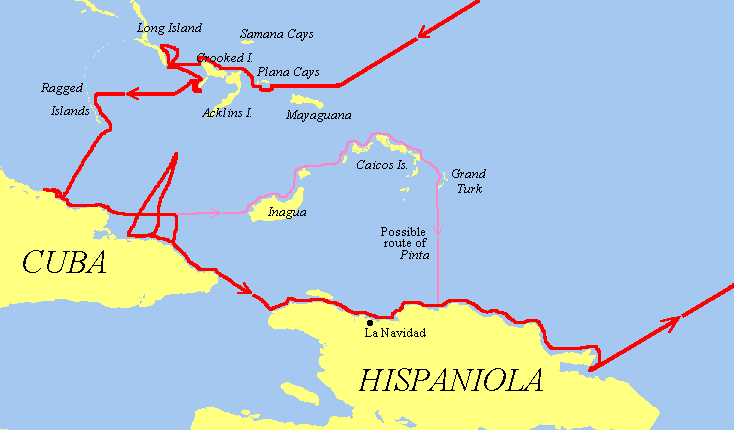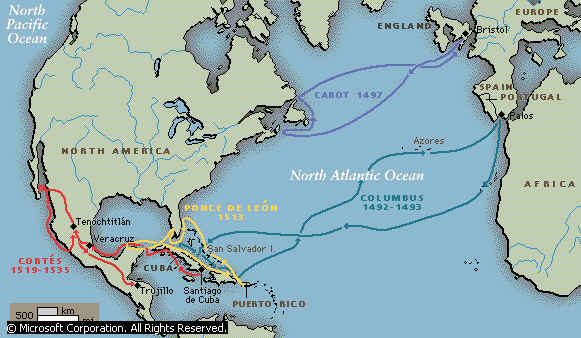
Second & Third Voyage
(The five dots before each pargapgh doesn't mean anything it's just the program wouldn't let me indent!)
.....The gold, parrots, spices, and human captives Columbus displayed for his sovereigns at Barcelona convinced all of the need for a rapid second voyage. Columbus was now at the height of his popularity, and at least 17 ships set out from Cádiz on Sept. 25, 1493. Colonization and Christian evangelization were openly included this time in the plans, and a group of friars shipped with him. The presence of some 1,300 salaried men with perhaps 200 private investors and a small troop of cavalry are testimony to the expectations invested in the expedition. The confiscated properties of expelled Jews had swelled the royal coffers and probably largely financed it.
....Sailing again via Gomera in the Canaries, the fleet took a
more southerly course than on the first voyage and reached
Dominica in the Lesser Antilles on Nov. 3, 1493. After sighting
the Virgin Islands, it entered Samaná Bay in Hispaniola on
November 23. Cuneo, deeply impressed by this unerring return,
remarked that "since Genoa was Genoa there was never born a
man so well equipped and expert in navigation as the said lord
Admiral." An expedition to Navidad four days later, however,
was shocked to find the fortress destroyed and the men dead. Here
was a clear sign that native resistance had gathered strength.
More fortified places were rapidly built, including a city,
founded on January 2 and named La Isabela after the queen. On
February 2 Antonio de Torres left La Isabela with 12 ships, a
little gold, spices, parrots, captives (most of whom died en
route), the bad news about Navidad, and some complaints about
Columbus' methods of government. While Torres headed for Spain,
two of Columbus' subordinates, Alonso de Ojeda and Pedro
Margarit, took revenge for the massacre at Navidad and captured
slaves, both seemingly with the admiral's full connivance. In
March Columbus explored Cibao (thought to be the gold-bearing
region of the island) and established the fortress of St. Thomas
there. Then, late in April, three ships, led by Columbus in the Niña,
explored the Cuban coastline and searched for gold in Jamaica,
only to conclude that Hispaniola promised the richest spoils for
the settlers. It was, the admiral decided, indeed the biblical
Seba (Saba in the Vulgate), and Cuba was the mainland of Cathay.
On June 12, 1494, Columbus insisted on a sworn declaration to
that effect--a sure indication that, though not all of the
company agreed with him, he was bent on insisting to his
sovereign that he had reached Cathay.
.....The year 1495 saw the determined conquest of the island
of Hispaniola and the beginning of troubles for the Taino
Indians. There is evidence, especially in the objections of a
friar, Bernardo Buil, that Columbus' methods remained harsh. The
admiral's brothers, Bartholomew and Diego, were left in charge of
the settlement when, on March 10, 1496, the admiral left La
Isabela for Spain. He reached Cádiz on June 11 and immediately
pressed his plans for a third voyage upon his sovereigns, at
Burgos. Spain was at war now with France and in need of buying
allies; moreover, the yield from the second voyage had fallen
well short of the investment. But Portugal still threatened, and,
though the two nations, in the Treaty of Tordesillas (June 7,
1494), had divided the Atlantic conveniently between themselves,
they had as yet made no agreement about rights in the East.
According to the treaty Spain might take all discovered land west
of a line drawn from pole to pole 370 leagues west of the Cape
Verde Islands and Portugal that to the east of the line; but what
about the other side of the world, where West met East? Also,
there might be a previously undiscovered antipodean continent;
who, then, should be trusted to draw the line there? Ferdinand
and Isabella therefore made a cautious further investment. Six
ships left Sanlúcar de Barrameda on May 30, 1498, three filled
with explorers and three with provisions for the settlement on
Hispaniola. It was clear now that Columbus was expected both to
find great prizes and to establish the flag of Spain firmly in
the East.
Third Voyage
.....Certainly he found prizes, but not, sadly, quite of the
kind his sponsors required. The aim this time was to explore to
the south of the existing discoveries, in the hope of finding
both a strait from Cuba/Cathay to India and, perhaps, the unknown
antipodean continent. Thus, on June 21, the provision ships left
Gomera for Hispaniola, while the explorers headed south for the
Cape Verde Islands. Columbus began the Atlantic crossing on July
4, 1498, from São Tiago Island in Cape Verde. He discovered the
principle of compass variation (the variation at any point on the
Earth's surface between the direction to magnetic and geographic
north), for which he made brilliant allowance on the journey from
Margarita Island to Hispaniola on the later leg of this voyage,
and he also observed, though misunderstood, the diurnal rotation
of the Pole Star. After stopping at Trinidad (named after the
Holy Trinity, whose protection he had invoked for the voyage),
Columbus entered the Gulf of Paria and planted the Spanish flag
on the Paria Peninsula in Venezuela. He sent the caravel El
Corréo southward to investigate the mouth of the Rio Grande
(the northern branch of the Orinoco), and by Aug. 15, 1498, knew
by the great floods of fresh water flowing into the Gulf of Paria
that he had discovered another continent--"another
world." But he did not find the strait to India, nor did he
find those mines of King Solomon's gold his reading had led him
and his sovereigns to expect in these latitudes; and he made only
disastrous discoveries when he returned to Hispaniola.
.....The rule of his brothers, Bartholomew and Diego, had been
resented there, by both the native inhabitants and the
immigrants. A rebellion by the alcalde (mayor) of La Isabela,
Francisco Roldán, had led to appeals to the Spanish court, and,
even as Columbus attempted to restore order (partly, it must be
said, by hangings), the Spanish chief justice, Francisco de
Bobadilla, was on his way out to the colony with a commission
from the sovereigns to investigate all the complaints. It is hard
to explain exactly what the trouble was. Columbus' report to his
sovereigns from the second voyage, taken back by Torres and so
known as the Torres Memorandum, speaks of sickness, poor
provisioning, recalcitrant natives, and undisciplined hidalgos
(gentry). It may be that these problems had intensified. But the
Columbus family's repressive policies must be held at least
partly responsible, intent as it undoubtedly now was on enslaving
the native population, both to work the placer mines of
Hispaniola and for export to Europe. The adelantado (governor)
Bartholomew Columbus had replaced Columbus' original system of
gold production, whereby the local chiefs had been in charge of
delivering gold on a loose per capita basis, by direct
exploitation through favoured Spaniards, and this had caused
widespread dissent among both unfavoured Spaniards and indigenous
chiefs. Certainly Bobadilla found against the Columbus family
when he arrived in Hispaniola. He clapped Columbus and his two
brothers in irons and sent them promptly back, on the La Gorda,
to Cádiz. They arrived there in late October 1500.
.....The long letter Columbus composed on the journey back and
sent to his sovereigns immediately on his return is one of the
most extraordinary he wrote, and one of the most informative. One
part of its exalted, almost mystical, quality may be attributed
to the humiliations the admiral had endured (humiliations he
compounded by refusing to allow the captain of the La Gorda
to remove his chains during the voyage) and another to the fact
that he was now suffering severely from sleeplessness, eyestrain,
and a form of rheumatoid arthritis, which may have hastened his
death. Much of what he said in the letter, however, seems
genuinely to have expressed his beliefs. One can learn from it
that Columbus had absolute faith in his navigational abilities,
his seaman's sense of the weather, his eyes, and his reading. The
last is apparent in his conviction that he had reached the outer
region of the Earthly Paradise. Thus, as he approached Trinidad
and the Paria Peninsula, the rotation of the Pole Star gave him,
he wrote, the impression that the fleet was climbing. The weather
had become extremely mild, and the flow of fresh water into the
Gulf of Paria was, as he saw, enormous. All this could have one
explanation only--they had mounted toward the temperate heights
of the Earthly Paradise, heights from which the rivers of
Paradise ran into the sea. Columbus had found all such signs of
the outer regions of the Earthly Paradise in his reading, and
indeed they were widely known. He was, then, on this estimate,
close to the realms of gold that lay near Paradise. He had not
found the gold yet, to be sure; but he knew now where it was.
Columbus' expectations thus allowed him again to interpret his
discoveries in terms of biblical and classical sources and to do
so in a manner that would be comprehensible to his sponsors and
favourable to himself.
.....This letter, desperate though it was, convinced the sovereigns that, even if he had not yet found the prize, he had been close to it after all. They ordered his release and gave him audience at Granada in late December 1500. They accepted that, although Columbus' capacities as governor were wanting (on Sept. 3, 1501, they appointed Nicolás de Ovando, not Columbus, to succeed Bobadilla to the governorship), those as navigator and explorer were not. Columbus, even ill and importunate, was a better investment than the many adventurers and profiteers who had meantime been licensed to compete with him, and there was always the danger (revealed in some of the letters of this period) that he would offer his services to his native Genoa. In October 1501, then, Columbus went to Seville to make ready his fourth and final expedition.


Voyage I.....Voyage II&III.....Voyage IV..... Letters..... Myths And Facts..... His Life..... His Ships.....Log.....Doors.....Bibilography.....Media.....